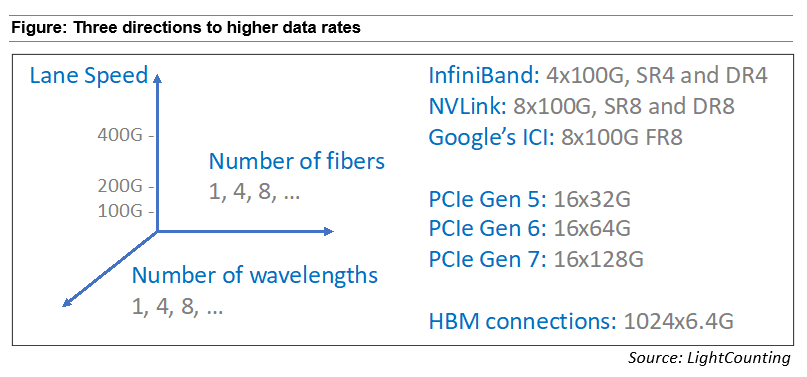Research Note

February 2024 To 224G and Beyond
Abstract
LightCounting reports on highlights from Photonics West and DesignCon 2024.
The two events were going in parallel on opposite sides of Silicon Valley at the end of January. Photonics West filled San Francisco’s Moscone Center with close to 20,000 attendees as usual. A much smaller venue for DesignCon in Santa Clara was packed with great discussions and many interesting demos.
DesignCon exhibits featured 3 demos of 224G SerDes and related components. We expect first products with 224G lanes to sample by the end of 2024. Cadence and Synopsys disclosed specifications and test data on their SerDes IP, designed for the 3nm TSMC process. Cadence disclosed that their long reach SerDes offers a 35-40dB loss budget. It seems that both solutions use Maximum Likelihood Sequence Estimation (MLSE) to improve performance. MLSE may become a standard feature for 224G and higher speed SerDes.
Marvell had two live demos of 224G components: one for a transmit module and one for a receive module. Both demos were hosted by Keysight and enabled by their latest test systems. The receive side was driven at 360G by Keysight’s generator to illustrate what is coming next. Yes, the industry is starting to work on 448G lane speeds and components supporting it.
Increasing data rates per lane (often referred to as lane speed) is only one of three possible directions to boost the bandwidth of optical interconnects, as illustrated in the figure below. Higher lane speed is a preferred solution for most of the Ethernet and InfiniBand interconnects. Direct I/Os to accelerators, such as NVLink to Nvidia’s GPUs or ICI to Google’s TPUs, also need the highest lane speed possible. Nvidia is using parallel types of transceivers (SR8 and DR8) now, but it plans to use multi-wavelength solutions as well in the future. Google is already using 8-wavelength FR8 transceivers.
Other types of connections to accelerators, such as PCIe and connectivity to High Bandwidth Memory (HBM) also shown in the figure, rely on a large number of lower speed lanes to achieve Tbps levels of connectivity. All of these connections rely on either copper cables or copper traces today, but future designs will need optical connectivity, as discussed in our recently published report “Optics for AI Clusters”.
LightCounting organized a session on next generation technologies for optics in AI clusters at the Photonics West exhibit and it drew a crowd. All the seats were taken and a row of standing attendees encircled the audience. The panel discussion included:
- Bijan Nowroozi, CTO, Open Compute Project Foundation (OCP)
- Uday Poosarla, Senior Director, Celestial AI
- Timour Rakhimi, Director of Business Development, Innolume
- Yosef Ben Ezra, CTO, New Photonics
Bijan Nowroozi opened the session by announcing the new initiative launched by the OCP to facilitate development of new solutions for short reach optical interconnects. More details on this initiative will be disclosed at the upcoming OCP regional summit. A white paper will be released by the OCP ahead of this event.
Celestial AI disclosed some of their plans which were tightly guarded until recently behind an enigmatic company name. The plans are ambitious and resemble the Trojan horse strategy pioneered millennia ago with a 21st century twist. Celestial AI’s IP allows the optics to be hidden in a substate or an interposer with 2.5D packaging under a GPU chip. The GPU would not know what is coming until night falls and it is too late. The only way for the GPU to send the data out will be via optics and the victory will be declared soon after that.
Full text of the research note is available to LightCounting clients at: https://www.lightcounting.com/login
